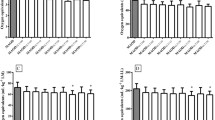Abstract
The reference points of the aerobic-anaerobic transition are currently regarded in performance diagnostics as specific parameters for characterization of endurance capacity as well as for determination of the optimal intensity for extensive and intensive long-distance training. This is the case, although the physiological mutual effects of the determining factors are not adequately clarified, nor is the validity of these parameters histochemically or biochemically confirmed with reference to sports-type specificity, age, or pathological conditions. The models for individual threshold determination which have been worked out in recent years [1, 7,11,12, 15–17] indicate the efforts made to validate the endurance performance capacity.
Access this chapter
Tax calculation will be finalised at checkout
Purchases are for personal use only
Preview
Unable to display preview. Download preview PDF.
Similar content being viewed by others
References
Bachl N (1981) Moglichkeiten zur Bestimmung individueller Ausdauerleistungsgrenzen anhand spiroergometrischer Parameter. Osterr J Sportmed Suppl 1
Baxter C, Reilly T (1983) Influence of time of day on all-out swimming. Br J Sports Med 17: 122–127
Chohen RD (1978) The production and removal of lactate. In: Bossart H, Perret C (eds) Lactate in acute conditions. Karger, Basel, pp 10–19
Van Dam B, Waterloh E, Knorzer H (1983) Der EinfluB von Tagesperiodik und Schweifiproduktion auf das Laktatverhalten unter Ergometerbelastung. Lehre der Leichtathletik 13: 24–26
Drexler H, Lollgen H, Bodemann H, Just H (1983) Zur Reproduzierbarkeit ergometrischer und hamodynamischer MeBgroBen. In: Mellerowicz H, Franz I-W (eds) Standardisierung, Kalibrierung und Methodik in der Ergometrie. Fachbuch-Verlagsgesellschaft, Erlangen, pp 88–94
Graham TE, Andrew GM (1973) The variability of repeated measurements of oxygen debt in man following a maximal treadmill exercise. Med Sci Sports 5: 73–78
Keul J, Simon G, Berg A, Dickhuth H-H, Kubel R, Goertler I (1979) Bestimmung der individuellen anaeroben Schwelle zur Leistungsbewertung und Trainingsgestaltung. Dtsch Z Sportmed 7: 212–218
Lollgen H, Haninger B, Just H (1980) Langzeitvariabilitat ergometrischer MeBgroBen. In: Kindermann W, Hort W (eds) Sportmedizin fur Breiten- und Leistungssport. Berichtsband Deutscher SportarztekongreB Saarbriicken. Demeter, Grafelfing, pp 273–285
Neumann S, Pannier R (1973) Tagesprofile der Blutkonzentrationen von Lactat, Pyruvat und Glucose, des Sauren-Basen-Status sowie der Pulsfrequenz bei gesunden Kleinkindern. Arzt Jugdkde 64: 453–460
Pannier R, Klimt F (1971) Blutmilchsaure — Tagesperiodik. Padiatr Pedol 6: 113–116
Pessenhofer H, Schwaberger G, Sauseng N, Schmid P (1983) Methodische Grundlagen zur Be-stimmung des individuellen aerob-anaeroben Ubergangs. In: Mellerowicz H, Franz I-W (eds) Standardisierung, Kalibrierung und Methodik in der Ergometrie. 4th Int Sem Ergometry, Berlin. Fachbuch-Verlagsgesellschaft, Erlangen, pp 193–199
Pessenhofer H, Schwaberger G, Schmid P (1981) Zur Bestimmung des individuellen aerob-anaeroben Ubergangs. Dtsch Z Sportmed 1: 15–17
Reilly T, Baxter C (1983) Influence of time of day on reactions to cycling at a fixed high intensity. Br J Sports Med 17: 128–130
Shephard R (1980) What can the applied physiologist predict from his data? J Sports Med Phys Fitness 20: 297–308
Simon G, Berg A, Dickhuth H-H, Simon-Alt A, Keul J (1981) Bestimmung der anaeroben Schwelle in Abhangigkeit vom Alter und von der Leistungsfahigkeit. Dtsch Z Sportmed 1: 7–14
Skinner JS, Mc Lellan T (1980) The transition from aerobic to anaerobic metabolism. Res Q 51: 234–248
Stegmann H, Kindermann W (1980) Modell zur Bestimmung der individuellen anaeroben Schwelle. In: Kindermann W, Hort W (eds) Deutscher Sportarztekongrefi, Saarbriicken. Sport- medizin fur Breiten- und Leistungssport. Demeter, Grafelfing, pp 227–233
Verstappen FTJ, Kuipers H, Keizer HA (1981) Reproducibility of aerobic power and related physiological variables in women. In: Borms I, Hebbelinck M, Venerando A (eds) Women and sport. Karger, Basel, pp 133–140 (Medicine and Sport, vol 14 )
Verstappen FTJ, Kuipers H, Keizer HA (1983) Daily variation in physical performance and its physiological correlates. In: Bachl M, Prokop L, Suckert R (eds) Current topics in sports medicine. Proceedings of the XXII world congress on sportsmedicine. Urban and Schwarzenberg (to be published)
Vogelaere P, De Meyer F, De Schrijver J (1983) Variations de repos de divers parametres cardiocirculatoires, enregistres journellement pendant une periode de 9 mois. Med Sport 57: 226–229
Wright GR, Sidney K, Shephard RJ (1978) Variance of direct and indirect measurements of aerobic power. J Sports Med 18: 33–42
Wyndham CH, Strydom NB, Maritz JS, Morrison JF, Peter J, Potgieter ZU (1959) Maximum oxygen intake and maximum heart rate during stenuous work. J Appl Physiol 14: 927–936
Editor information
Editors and Affiliations
Rights and permissions
Copyright information
© 1984 Springer-Verlag Berlin Heidelberg
About this paper
Cite this paper
Bachl, N. (1984). Specificity and Test Precision of the Anaerobic Threshold. In: Löllgen, H., Mellerowicz, H. (eds) Progress in Ergometry: Quality Control and Test Criteria. Springer, Berlin, Heidelberg. https://doi.org/10.1007/978-3-642-69844-6_14
Download citation
DOI: https://doi.org/10.1007/978-3-642-69844-6_14
Publisher Name: Springer, Berlin, Heidelberg
Print ISBN: 978-3-540-13570-8
Online ISBN: 978-3-642-69844-6
eBook Packages: Springer Book Archive




